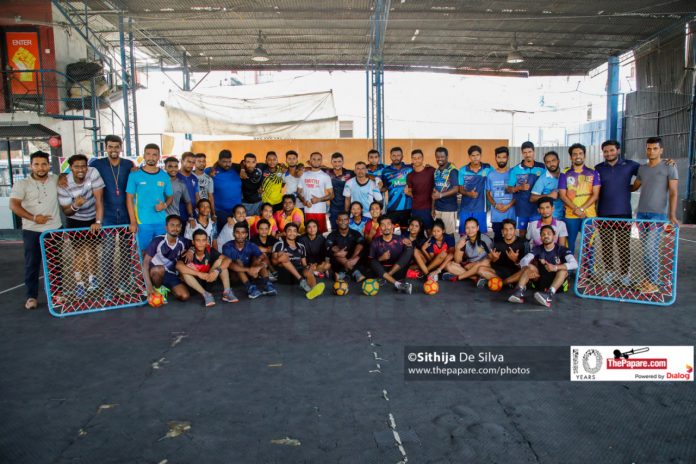Tchoukball in Sri Lanka, is a rapidly growing sport that is looking to spread the message of peace-building through sport.
Tchoukball, a sport alien to many, is the fastest handball sport in the world. With a short history of not even half a century, Tchoukball is currently played in 70 countries across the world. It is a sport that involves many core skills from many different sports. The passing strategy and the ball is similar to that which is used in Handball, the rebounding effect of the frame draws many a similarity with Squash while the ball dashing strategy and defence look a lot like what we see in Volleyball.

Tchoukball is played with 7 players on the court and 5 subsidiary players on the bench, adding a total of 12 players in a team. A standard game will go on for three periods of 15 minutes each with a 5-minute break in between periods. The game is usually an indoor sport played on a basketball court enclosed within a 27m x 17m area, however the newer from of the sport, beach tchoukball uses a court of the size of 21m x 12m. The speciality of the court in this game is the “forbidden zone”, technically a semi-circular area drawn to the radius of 3m around the scoring frame, which as its name suggests is a forbidden area.
The Tchoukball Charter documents all rules and regulations of the sport with special attention given to the game’s simplicity and discipline, harping on respect within one’s self, within the team and during play. The basic disposition of the game rallies on the motto ‘A Sport For All’ moving away from stiff competition and composed as a tool of peace building.
The evolution of Tchoukball dates back a few decades to the 1970s when Dr. Herman Bandt, a Swiss biologist brought the topic of the adversities of team sports through his research on ‘A Scientific Criticism of Team Games’. Understanding the importance of physical activity, he created awareness on severe injuries that are caused by many contact sports in the world today. After critically analysing the existing major games of the world, Dr. Brandt succeeded in constructing a new sport in Tchoukball, one which would hopefully minimize the risks faced when playing other sports.

The game revolves around the number 3: 3 seconds, 3 steps and 3 passes. The ball used for the game can only be held by a player for three seconds. Each team can pass the ball only between three players of the same team before attempting to score. The players are also penalized for moving with the ball for more than 3 steps. Unlike the mainstream team sports, the point system in Tchoukball also celebrates simplicity, awarding one point at a time. Both teams can score on either end of the court.
The Rules
The team with the ball gets a point if:
- The other team does not catch the ball off the rebounder.
The other team gets a point if :
- The shooter misses the rebound surface when he shoots the ball.
- The shooter shoots the ball and it bounces back, touching him.
- The shooter sends the ball into the forbidden zone, before or after it hits the rebound surface.
Penalties
A player commits a penalty if:
- He takes more than 3 steps while in possession of the ball.
- He makes a fourth pass for his team.
- He goes into the forbidden zone while holding the ball.
- He drops the ball after it is passed to him.
- He voluntarily, or by error, catches a pass from the other team.
- He catches a ball off of the rebound surface that was shot by one of his teammates.
- He blocks his opponents from moving or stops them from freely passing the ball once they have gained possession.
Particular rules
- There are no designed sides (each team may shoot the ball at either rebound).
- It is illegal to intercept a pass from the other team.
- No more than three passes before shot.
- No more than three steps by a player holding the ball.
- No more than three seconds holding the ball.
Specials Zones
In front of each rebound surface is a semi-circle with a three-meter (9.9 ft) radius, which is called.
the forbidden zone. A player may not be in the forbidden zone unless he has just shot or passed.
the ball. Either case, the player’s feet may not be in the forbidden zone if the ball is still in his hands.
The game of Tchoukball revolves around the significant qualities of team play, concentration, respect and empathy. Understanding the personal development of an individual through the conduct of sports, Tchoukball was introduced to Sri Lanka to spread the common message of the game.
“Tchoukball is not to make champions, but rather to help construct a harmonious society and we have seen how Tchoukball helps people to come together as one community.” –President of the South Asia Tchoukball Federation and Founder of Tchoukball in Sri Lanka Jonathan Wijesinghe said.
With the noble objective of peace building within the contours of Sri Lanka, Tchoukball is not only a powerful “tool” but also a clear reflection of strength in diversity. Tchoukball in Sri Lanka connects the cross-sectional vibrancy of the Island, bringing together individuals from the Northern, Southern, Eastern, Western and Central Provinces entrusted with the formula of ONE BALL – ONE COMMUNITY – ONE SRI LANKA.
Currently Sri Lanka boast a tally of 1800 trained players. Tchoukball in Sri Lanka assembles the youth from schools, universities and the working community, irrespective of their sporting backgrounds and experience. Entering the international grounds of Tchoukball last year, Sri Lanka managed to claim seventh place in the Asian arena. With 24 coaches with an ‘International Coach License’ and 15 individuals experienced in the game in the International Arena, Sri Lanka have a chance to take this ‘new sport’ all the way and make a name for themselves in the international arena.


















